I’ve returned from the store with a hacksaw. The bones are too thick for my chef knife, even after googling “how to sharpen a kitchen knife” and spending a solid five minutes winnowing the blade on my sharpening steel.
As I saw through the meat, it warms in my hand. I start to smell it once I reach the bone. You know the smell of a new book versus an old book, one you’d find at a yard sale? The difference in scent between regular beef and aged beef is kinda like that — and if you’re like me, you love the smell of old books. Earthy, musty, with a hint of cheese... This is the aroma leaking from the 15 pounds of angus prime rib I’ve been dry-aging in my kitchen for the past 28 days.
I like to eat, and I like to experiment with my food. During my years in New York, I’ve grown habanero peppers on my fourth-story windowsill; I’ve pickled; I’ve made jam; and, most recently, I managed to smoke a beef brisket on a rooftop in Manhattan.
So the moment I became aware of this guide for dry-aging beef at home using nothing but a mini fridge, I knew I had to try it. I love steak, but sadly my wallet rarely allows me to enjoy a good one, particularly a dry-aged specimen that can cost upward of 100 bones.
For the uninitiated, dry-aged beef is the cat daddy of the steak world. During the aging process, natural enzymes in the beef break down muscle tissues. This makes aged steaks more flavorful, more tender, and more interesting. And when aged for weeks, the steak takes on a distinct blue cheese taste some people love.
"Dry-aged beef is the cat daddy of the steak world."
The dry-age challenge felt like something I’d been working toward my entire life. My high school friends and I were committed carnivores. On any given Saturday night, you could find us in the butcher department of our local grocery store. We’d each buy a prime cut and a potato and then retreat to one of our houses, fire up the grill, and grill the steaks alongside potatoes wrapped in foil. Once the steaks were ready, we would feast. This was our truth, and we were living it.
That was ten years ago. Now it's time I try something bolder, something more extreme, something that would transcend the flavors of every home-grilled steak I’d ever eaten. And that something was 15 pounds of dry-aged ribeye.

Dry-aging at home is so simple that I’m astounded more people don’t do it. All you need is a mini fridge, a small fan, salt, and your meat.
This is my Brooklyn kitchen — photographic proof anyone and everyone has the space to dry-age meat. I installed my fridge in a convenient corner nook.
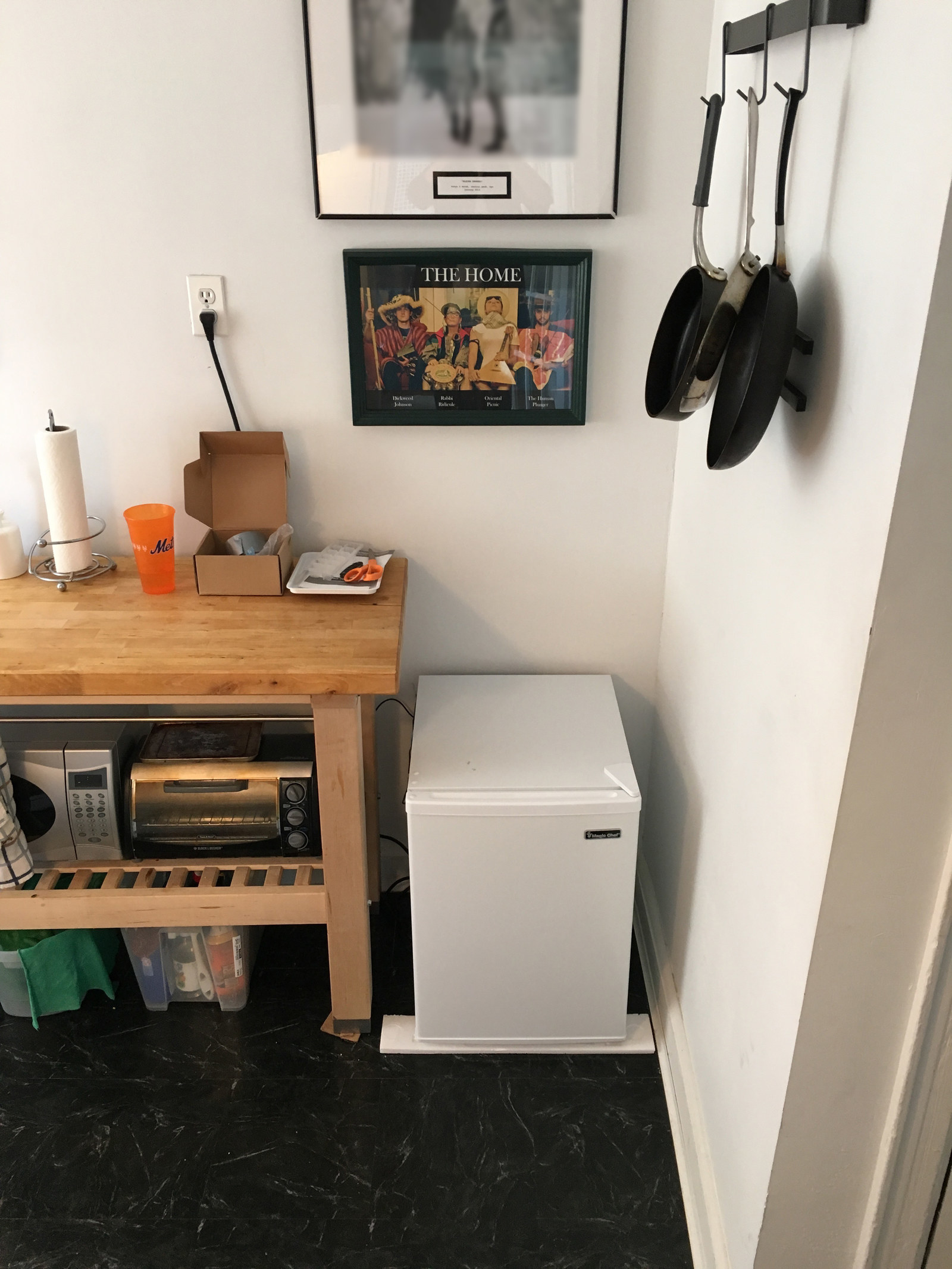
I unscrewed the stand from my USB desk fan so it would fit in my fridge door rack. I poured two pounds of sea salt into a tray to place at the bottom of the fridge (the salt absorbs moisture in the air that might cause your meat to mold). Lastly, I cut a notch in the fridge door seal so the fan cord fit out.
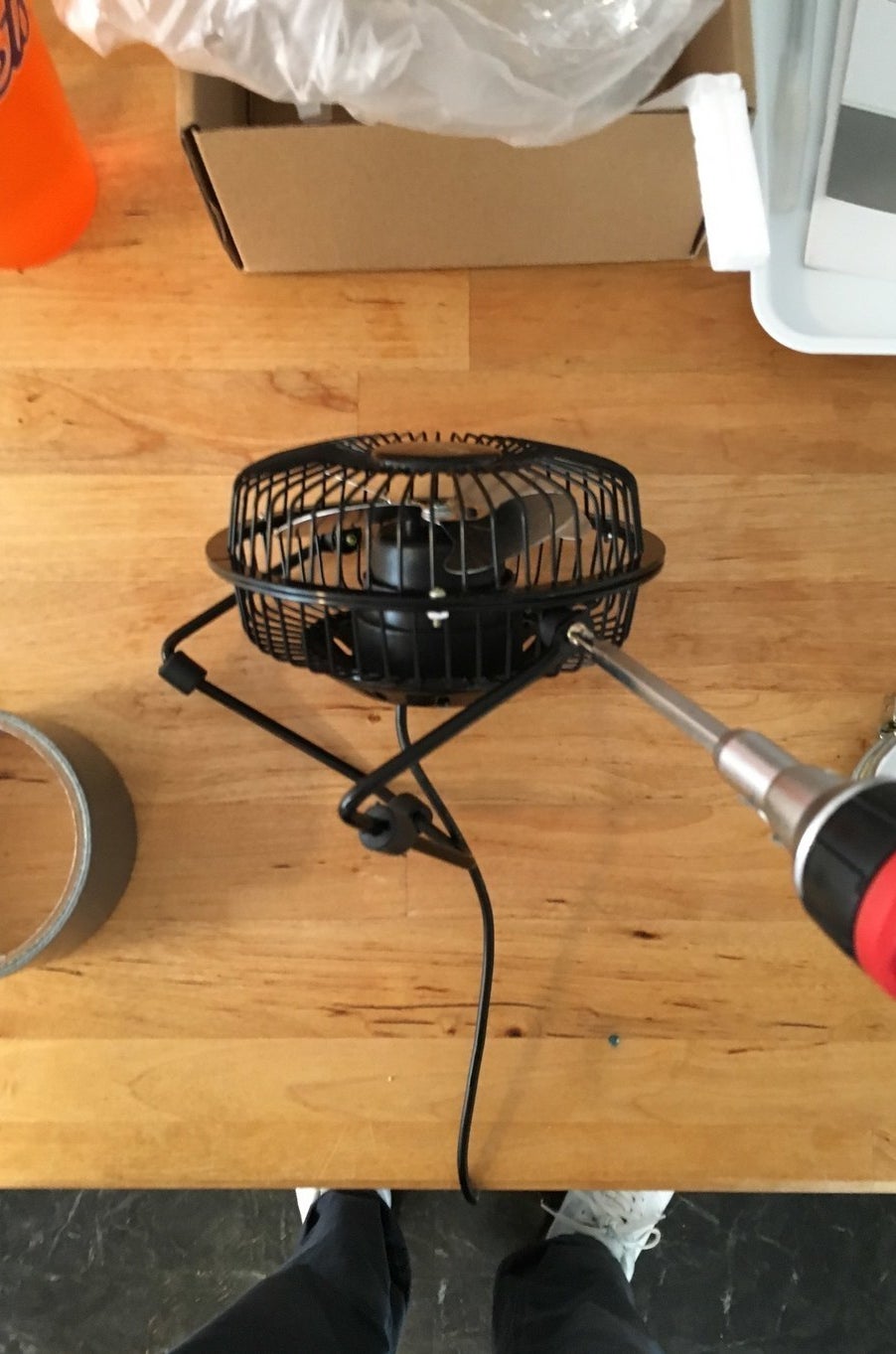
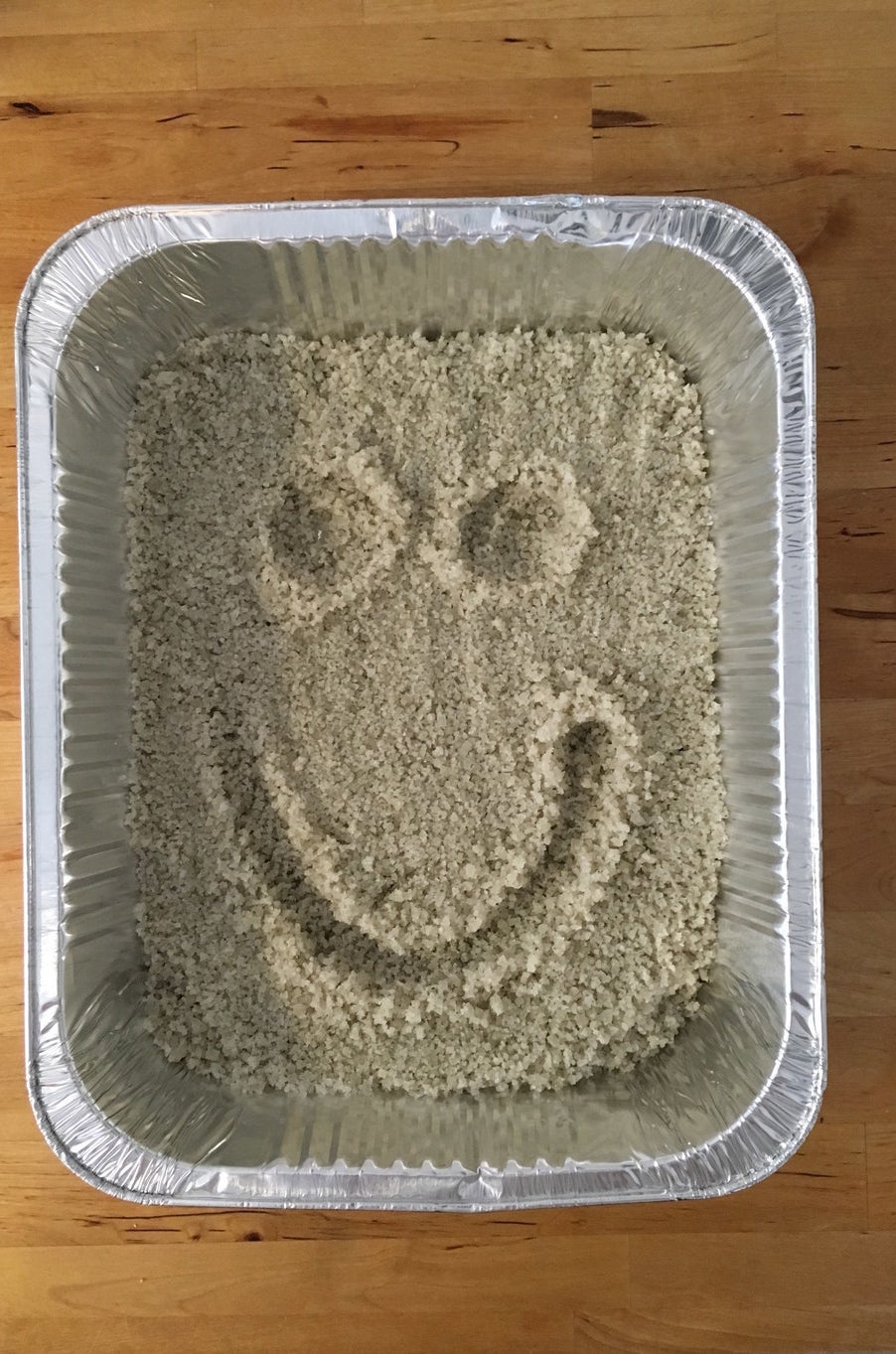
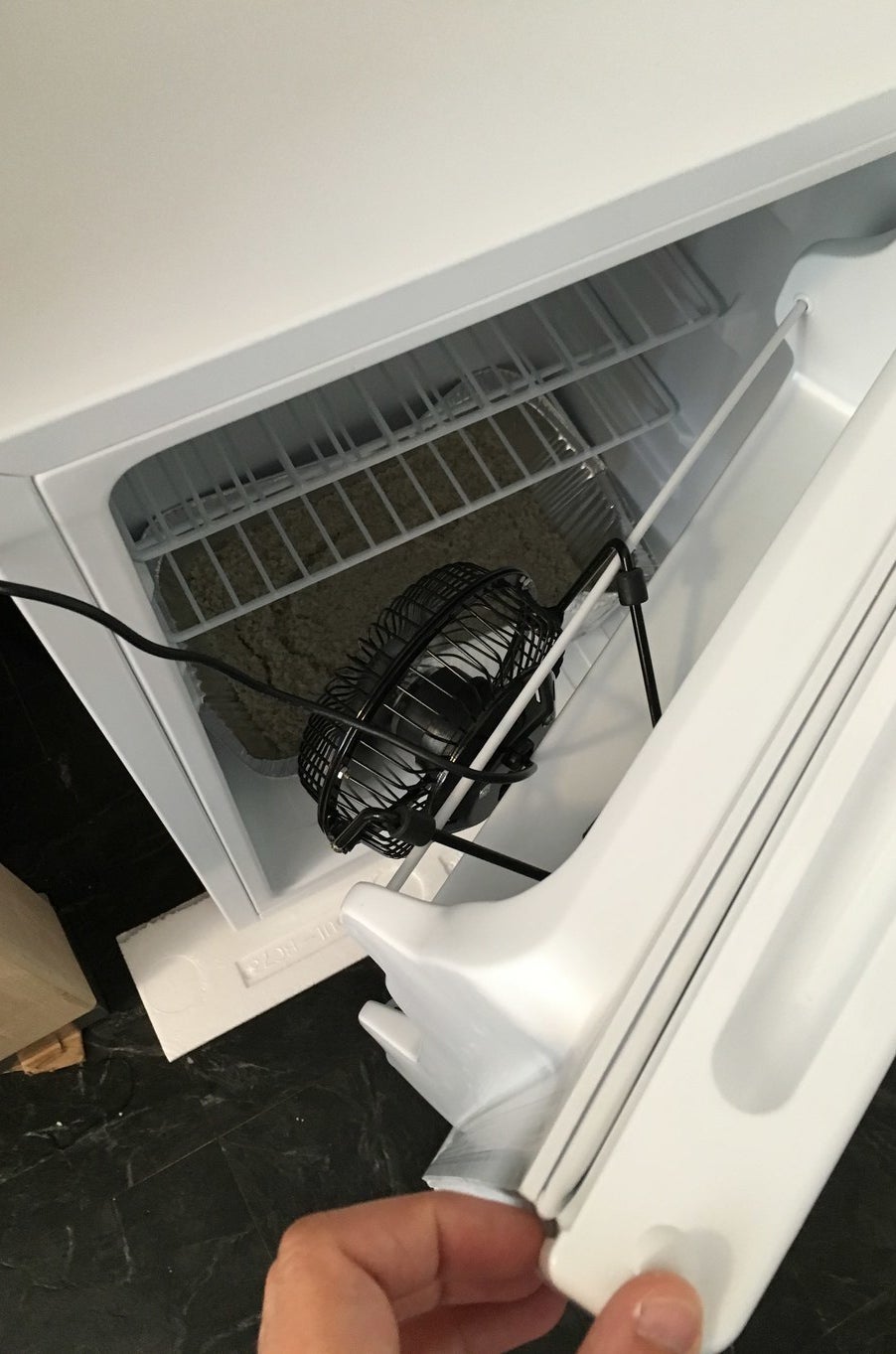
Next came the meat. With dry-aging, the adage “go big or go home” definitely applies. You cannot dry-age single steaks for any significant period of time because desiccation (aka moisture loss) will turn your steak into a tough black strip of dry flesh. Technically, you might be able to cut all that off and recover a sliver of good meat from the center, but that would hardly be worth the effort.
So...I bought 15.22 pounds of prime rib, which would (hopefully) become ribeye after the aging process. I asked the butcher to leave it totally untrimmed. All the extra bone and fat on an untrimmed cut will dry out and desiccate, effectively shielding the inner meat from spoiling. This means more edible meat after 28 days. In hindsight, this was a bit overkill. I should have saved myself time and asked the butcher to remove the chime bone (that protruding horn-looking thing above the ribs) with her bandsaw. However, the chime bone did help the prime rib stand up straight.


Once I had everything in place, I put my prime rib in the fridge and the USB fan in the door. But I had a problem! The prime rib was so tall that it wouldn’t fit. I had to give my fridge a “rack job” and lower the shelf using two shot glasses. Even though the shelf was off the shelf tracks, it was plenty sturdy for my prime rib. Ingenuity won the day.


Once everything was set, I closed the fridge...and waited.

This part was extremely easy. Every week or so, I would open the door expecting to find a rotted, disgusting mess. And every week, I was surprised to find the steak relatively unchanged. It was desiccating nicely, which was a good sign.
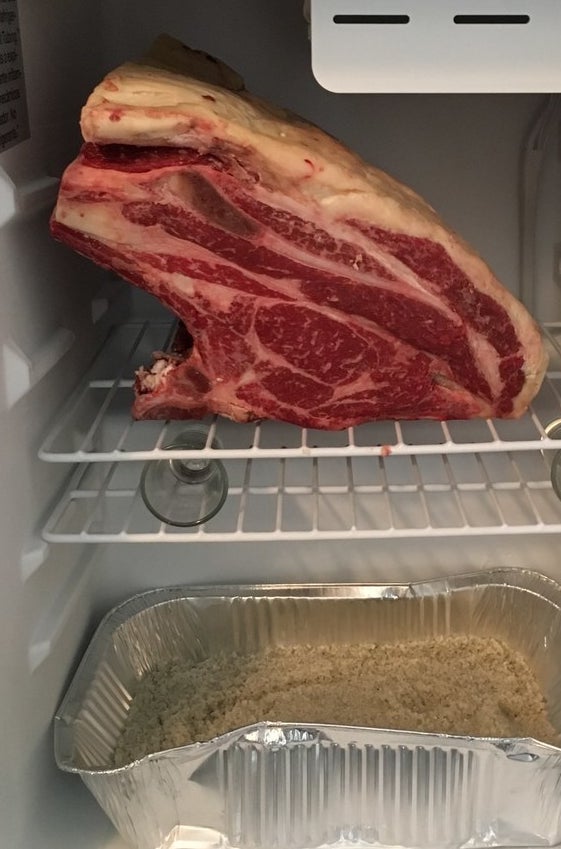
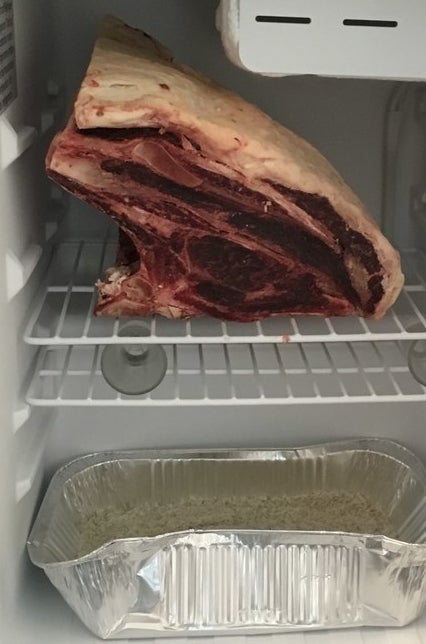
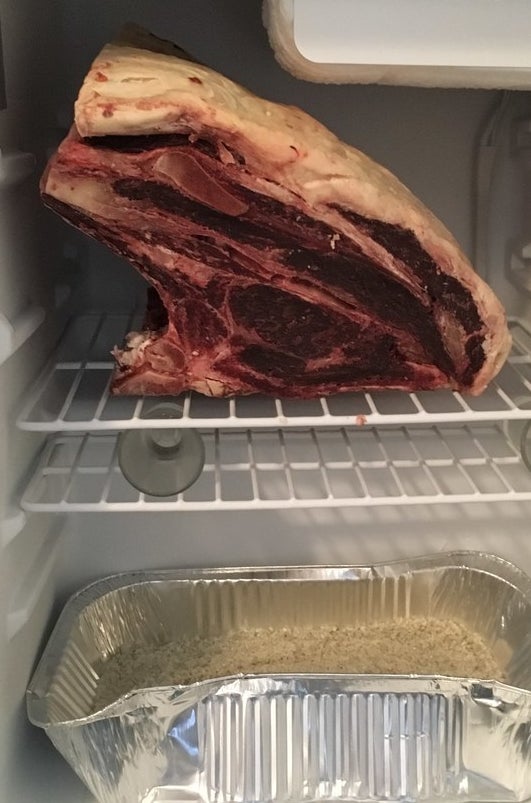
Each week, I moved my fan around to ensure the airflow varied and checked the fridge temperature. My aging guide said to keep the temperature around 40, but my local butcher told me he keeps his aging room at 35. I didn’t want to take any chances, so I cranked my fridge down to just above freezing. The temperature wasn’t totally consistent in the fridge. The area near the top where the cold air is made was significantly colder. But that was OK. The thick fat cap insulated the good meat from my freezer box.
Twenty-eight days felt like a long time, but it passed quickly. Then finally, one day, I realized it had been a month. Huzzah!
Twenty-eight days later, my prime rib resembled a zombie from that movie of the same name.
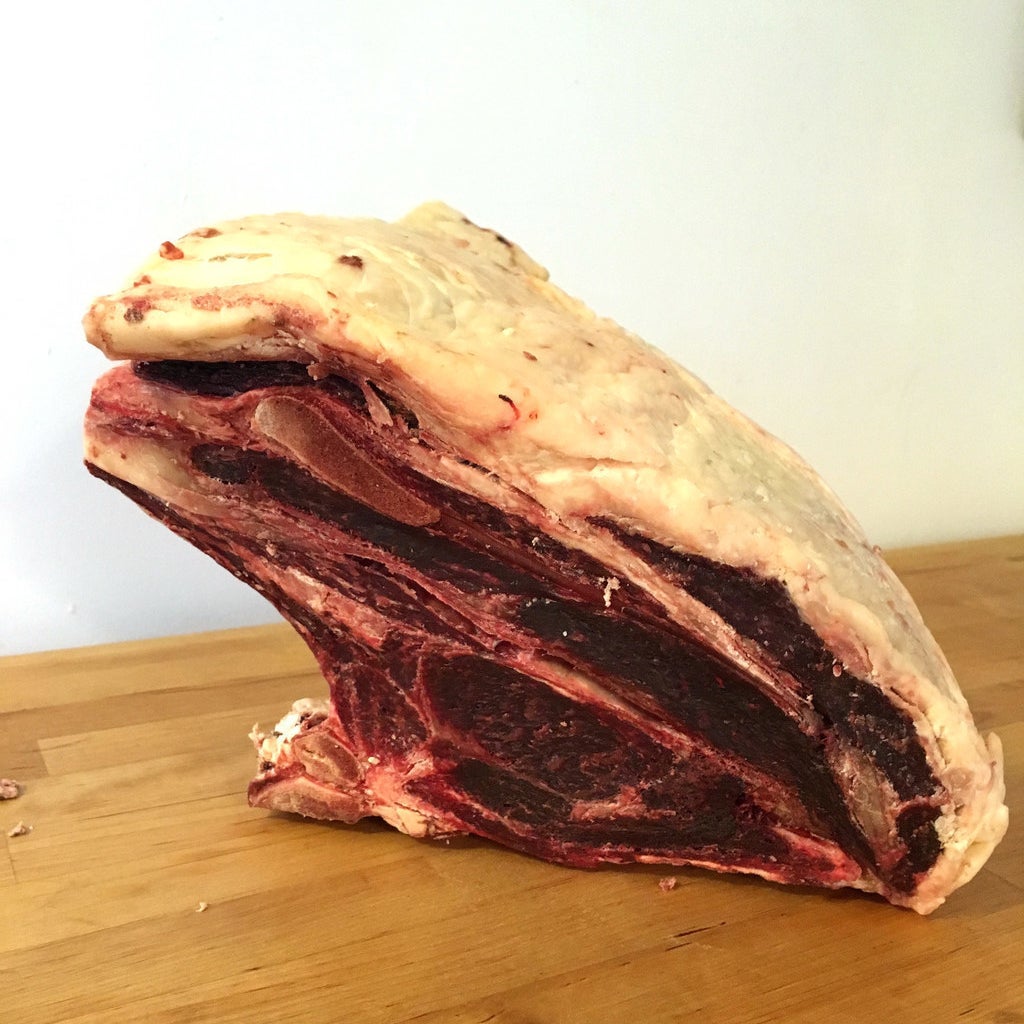
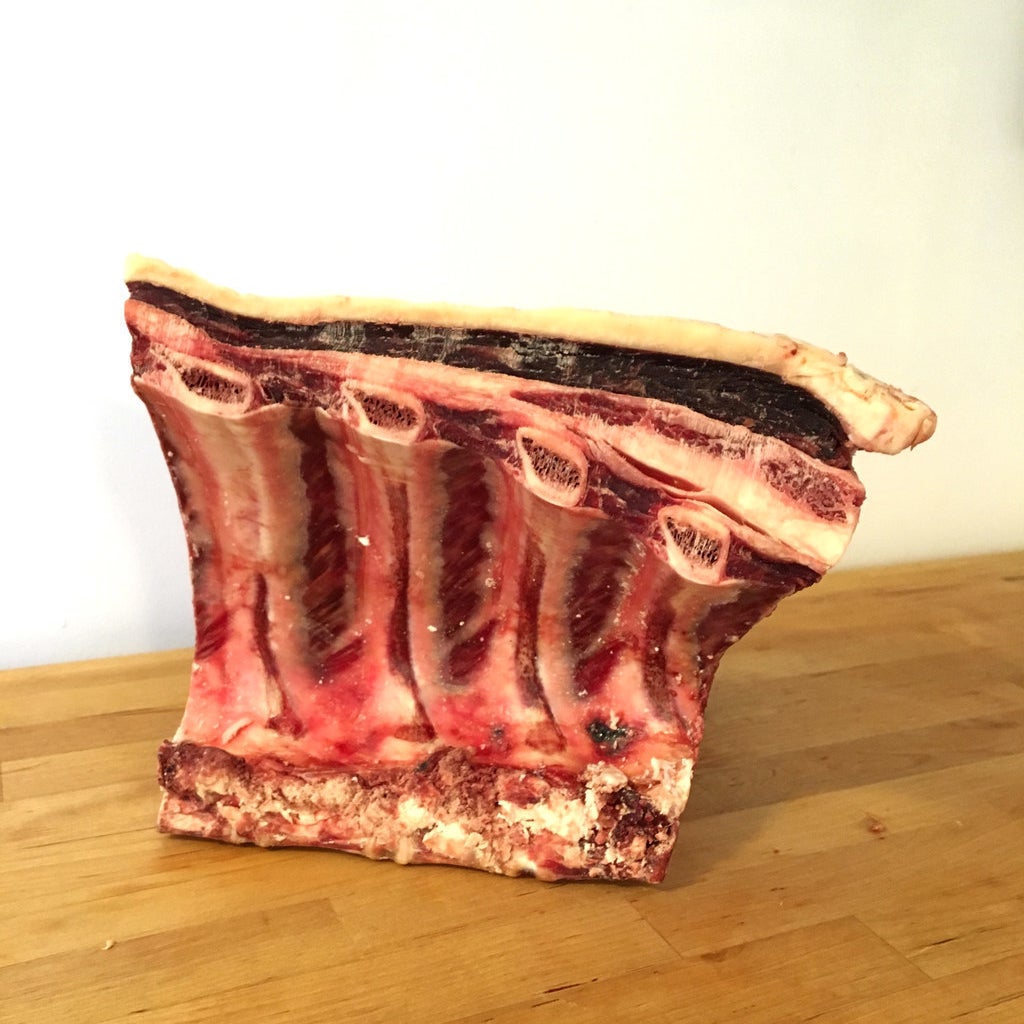


Butchering this prime rib was the most demanding culinary challenge I have ever encountered. Dear butchers of the world: You are strong, you are powerful, and you are patient. When I pulled my prime rib out of the fridge, I foolishly believed I would turn this 15 pounds of flavor into steaks within a few minutes. Four hours later, I was still sawing through rib bones…
First, I realized my chef knife was NOT going to make it through the bones, no matter how much weight I put behind it. So I ran out and bought a hacksaw. Major key. I sawed and sawed and sawed, watching as I made precious little progress through each of the bones. This was a workout. By the end, I had a serious case of moist forehead and very tired wrists. All my tools got slippery from the mixture of beef fat and man sweat.
But at last, I was able to divide my prime rib into five gigantic ribeyes. I carved each one away from the feather bones, sawed off the chine bones, and trimmed all the excess fat. If all these words mean nothing to you, that's OK! They meant nothing to me until I looked up YouTube butcher tutorials. You don't need culinary school to identify the parts of the prime rib.
And at last, my beautiful ribeyes were ready for the grill.
Proud steak dad pictured below.


(PSA: I encourage everyone to try butchering a steak at home. It's a fulfilling process that will help you appreciate the food you eat and the work that goes into it. Butchery is something they should teach in schools — along with other necessary life skills, like personal finance and wilderness survival.)

Cooking these steaks was the easy part of this process. First, I oiled my steak in olive oil. Next, I seasoned with Chicago Steak Seasoning (thanks, Weber Sauces & Seasonings!) and let them reach room temperature for about an hour while I prepped the grill. Pro tip: The oil both helps the seasoning stick to your meat and keeps your meat from sticking to the grill. Always oil the steak, not the grill!


Not too much! We want to enhance the flavor of our steak, not overwhelm it.
I loaded my Weber kettle with charcoal and heated it to a scorching 600+ degrees. I pushed the charcoal to one side to create a two-zone cooking system: one side burning lava hot, the other side warm through indirect heat.
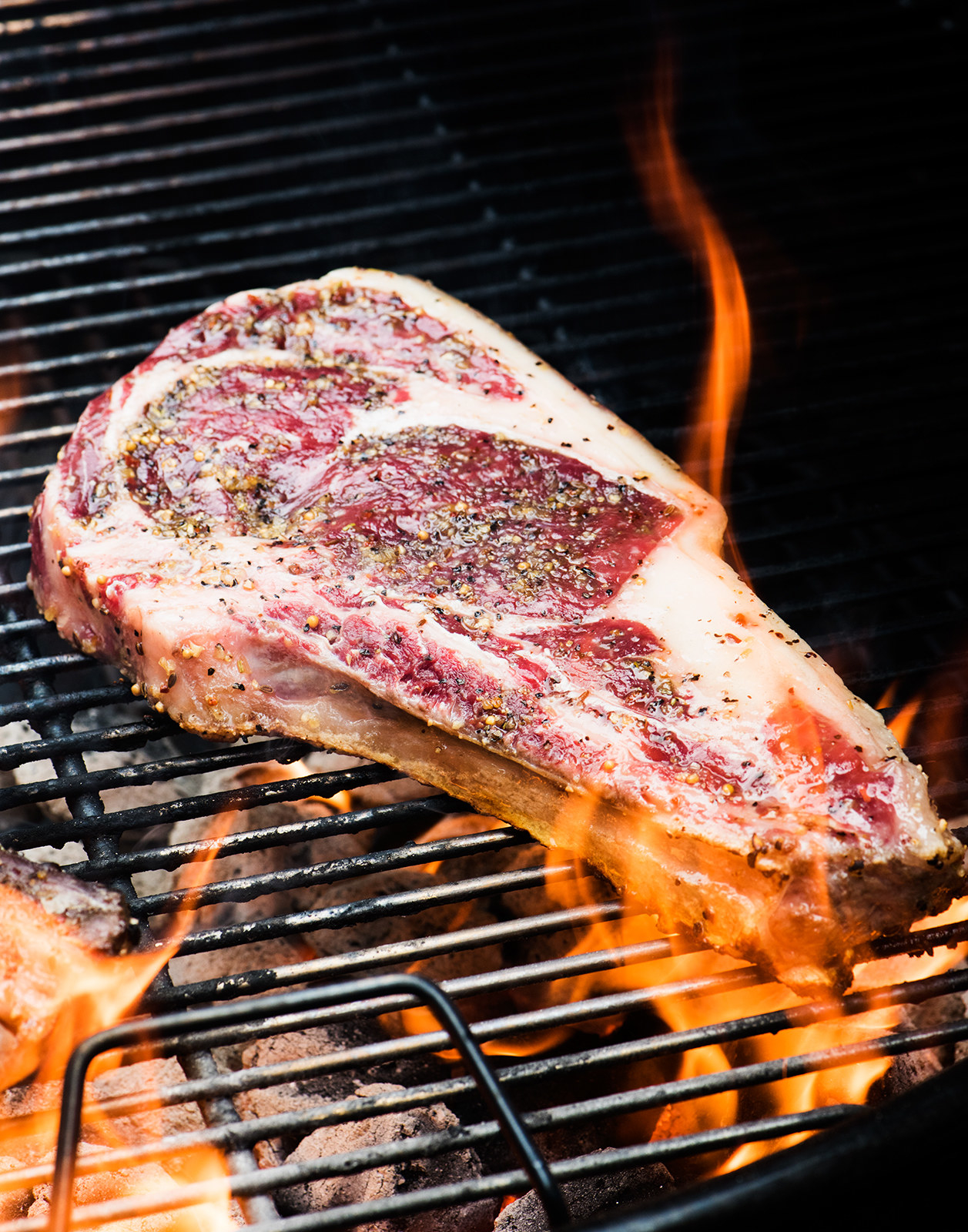
After the steaks marinated in their seasoning for an hour, I seared the steaks on each side for three minutes and then moved them to the cool side of the kettle until the internal temperature hit medium rare.
Twenty-eight days of work took less than 15 minutes on the grill. And at long last, I could taste my beautiful creations.
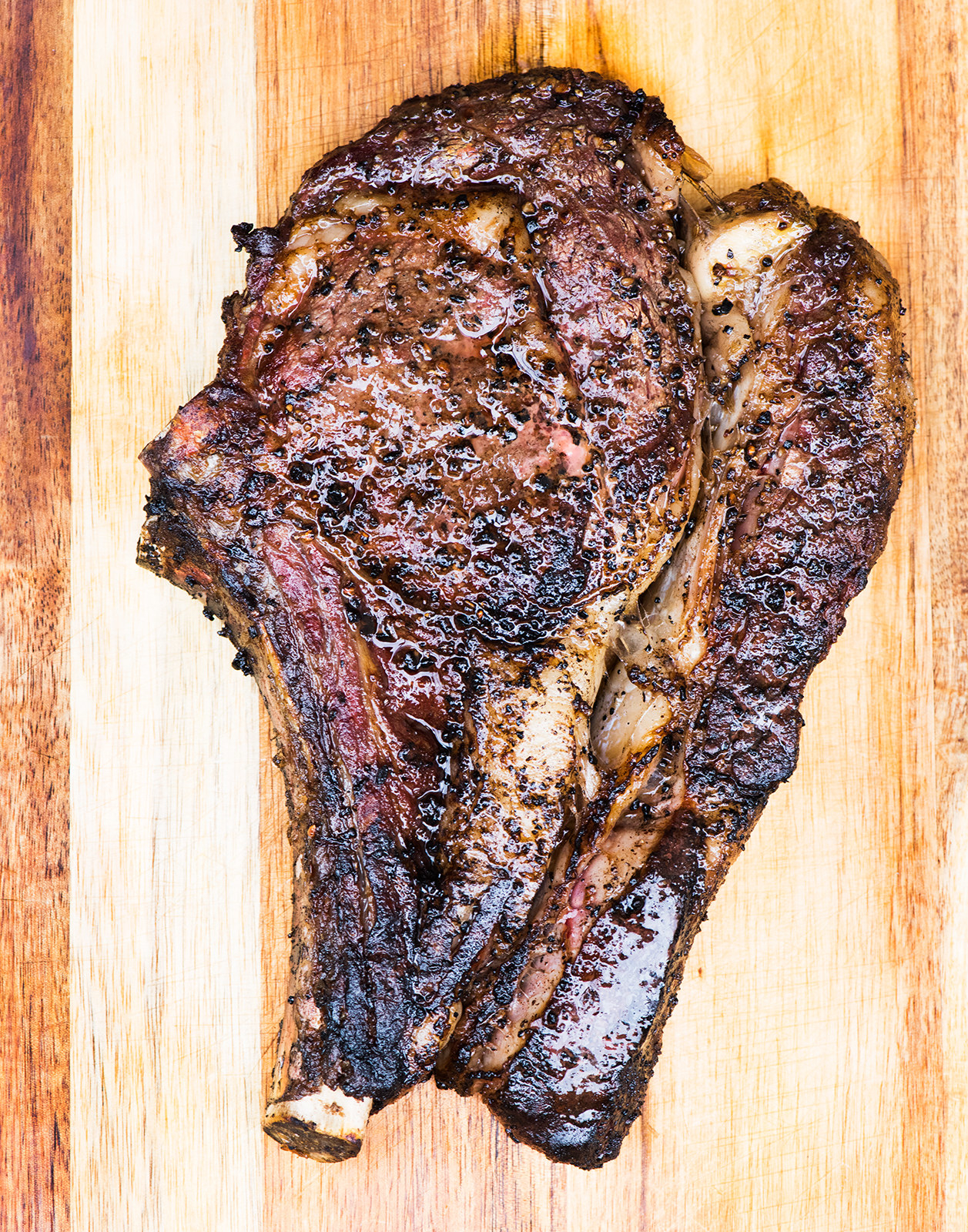

In order to really test the dry-aged brouhaha, I had a secret weapon: an unaged ribeye steak, cut from the same grade of prime rib from the same butcher who sourced from the same farm, which I cooked alongside my aged steak for precisely the (you guessed it) same amount of time. Every experiment needs a control group, and this was mine.
The test was simple: I'd serve both steaks to three friends without identifying which steak was aged. I would then ask said friends which steak they preferred and why. Would my dry-aged steak win? Would the judges immediately recognize the supposedly ~incredible~ qualities of the dry-aged steak and find themselves in flavor hysterics?
Spoiler alert: They did. All three immediately guessed that the tastier steak was the dry-aged steak.
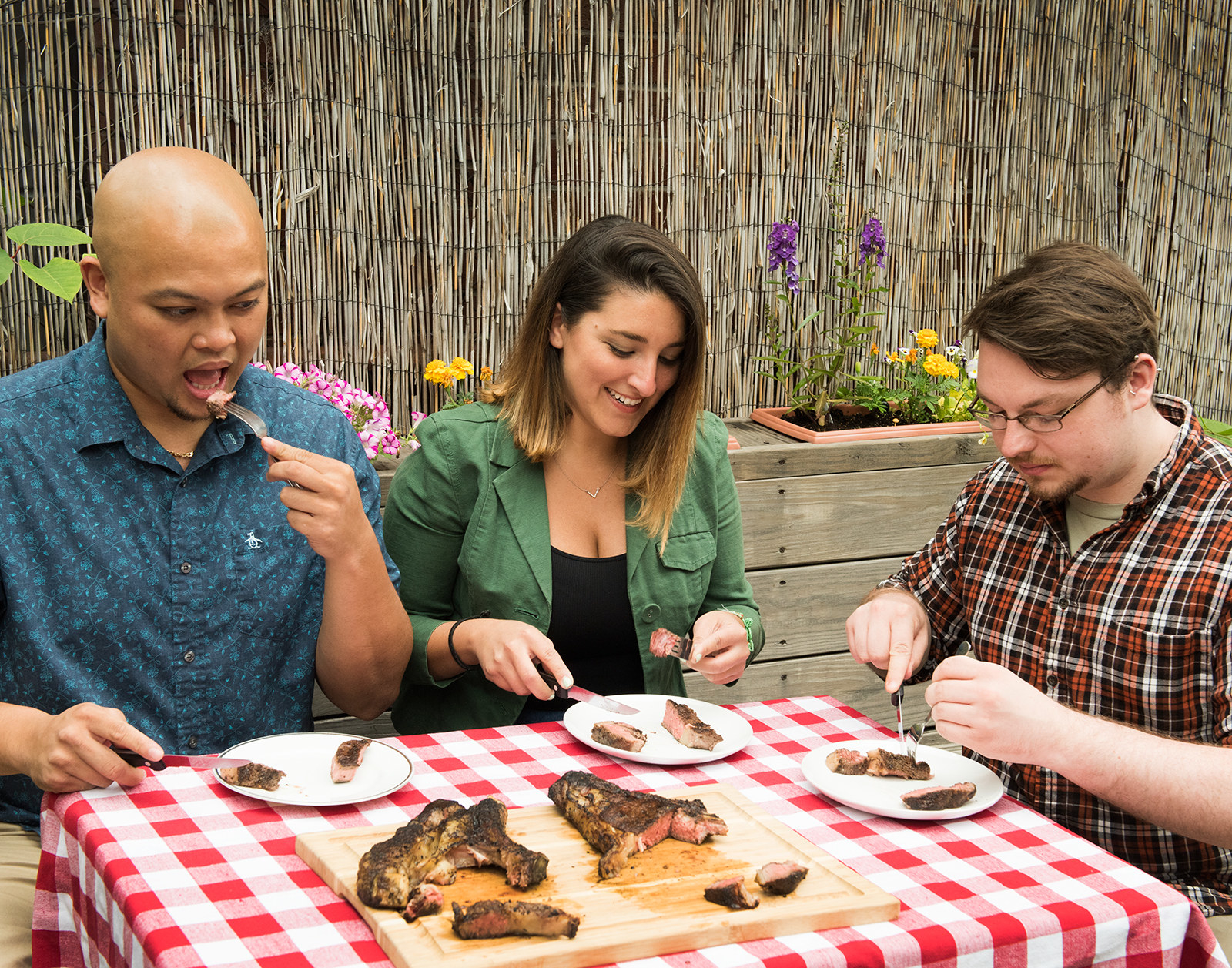
I asked each of them to describe the flavor.
Chris: There was no comparison. The dry-aged steak had a better texture and flavor. The melt-in-your-mouth texture was a noticeably better experience when compared to the chewier regular steak. As for the flavor, the dry-aged steak had a deeper flavor profile. Very umami. Makes total sense for the associated price tag. Totally worth it!
Stephanie: The seasonings on both were really great and complemented the natural flavors of the steaks. However, the dry-aged steak certainly kicked everything up a notch, and the meat was more tender. I might not have the patience to dry-age a steak for 28 days, but I can appreciate good flavor when I taste it and know that my old salt-and-pepper ways will definitely not cut it anymore! Now I'm spoiled!
Dan: The dry-aged steak was the clear winner...like, laughably so. It fell apart under my knife and melted in my mouth. The flavor itself was amazing too — a subtle smoky, peppery taste. It was just...steakier. I think I've been converted into a steak fan.
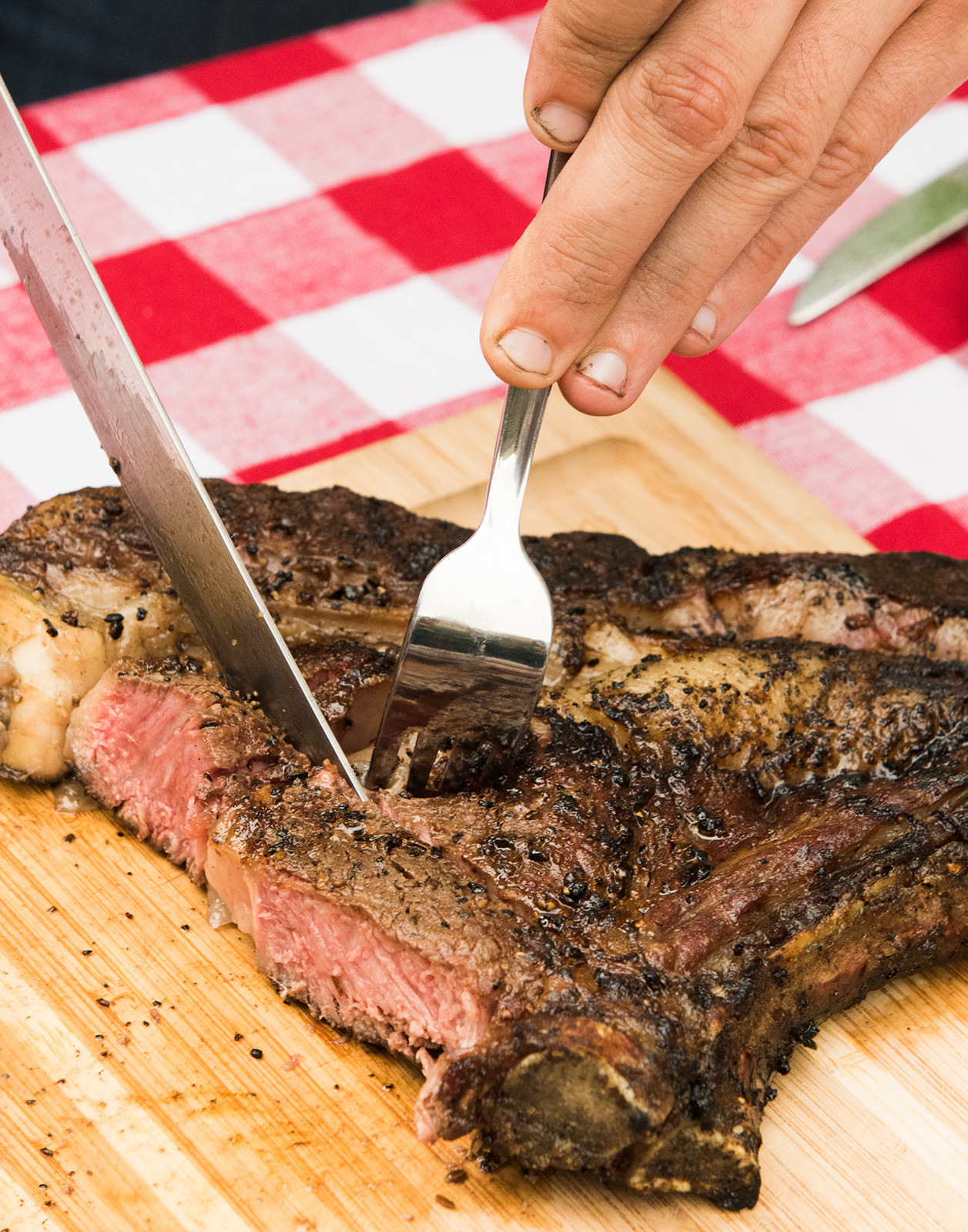

And what did I think? To be completely honest, this was the one of the best steaks I’ve ever eaten. This was a steak worth bragging about. I was shocked how much dry-aging enhanced the flavors. The meat was more tender, more unctuous, and more beefy. The Weber Chicago Steak Seasoning was also the perfect blend; it made the flavor interesting without overpowering the natural flavors of the meat. And underneath the flavor profile, the aged scent persisted. The old-book smell that exploded from the prime rib during butchering was still there, lingering in my mouth and giving the steak an extra something that both tasted pleasant and reminded me of the journey I undertook to get here.
After trying out this experiment, I think everyone should be dry-aging everything. I want a culture of home-cured and home-aged meats to take off like home-brewing has in recent years. The product is simply too delicious, and the cost savings are too extreme. Restaurant steaks prepared by professional chefs will always have a place in this world, but more people should undertake the aging process; it just tastes too good not to.
So go forth, people, and age! (And don't forget to bring a hacksaw.)
Dry-age your way to legendary flavor this summer with a little help from the perfect seasoning.
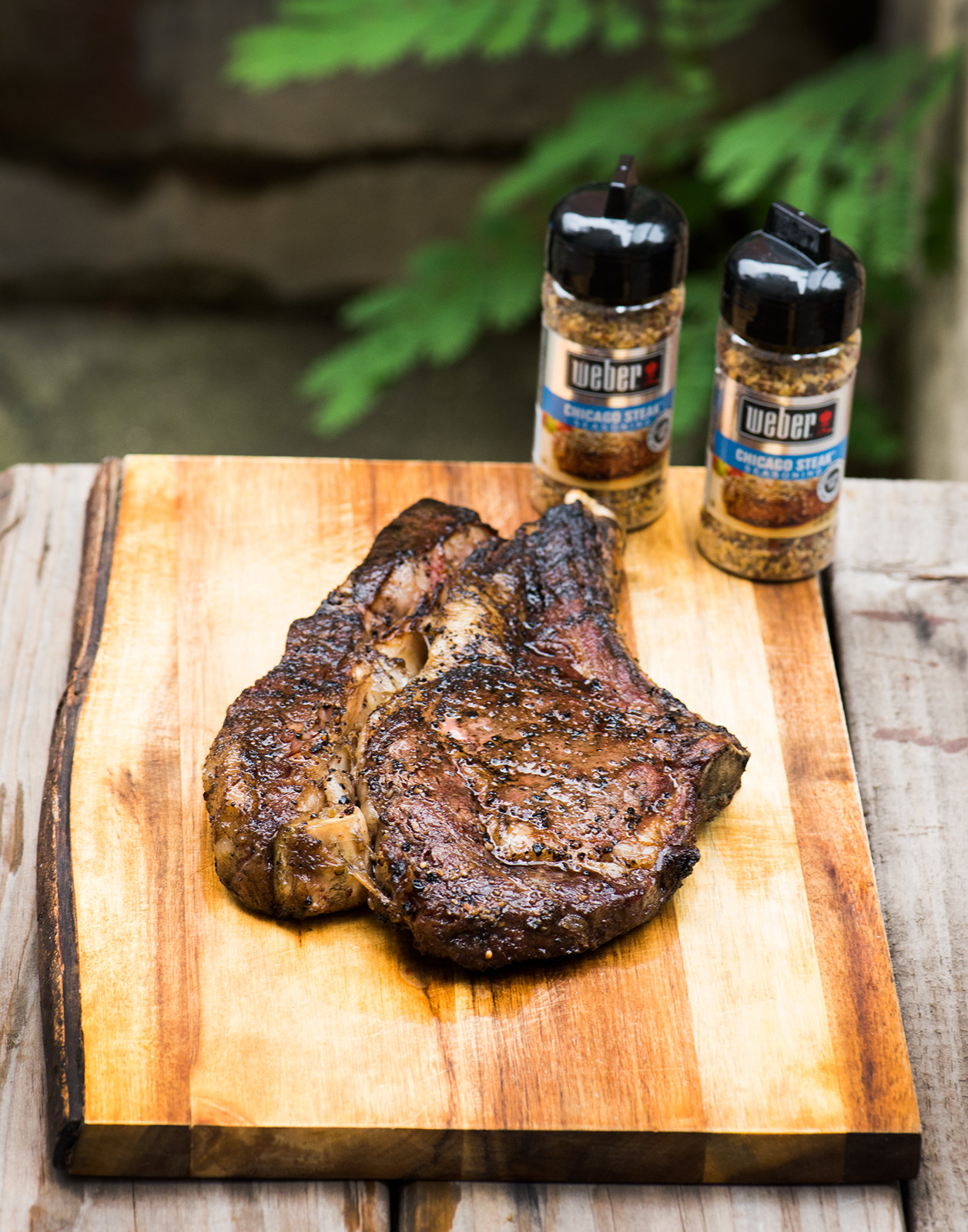
Chicago Steak Seasoning from Weber Sauces & Seasonings is expertly crafted for the grill. Salt and pepper are blended with garlic and other flavorful spices to embolden the natural flavor of your favorite steak — aged or un-aged.
Take this survey. It's just like taking a quiz!
Photographs by Lauren Zaser
Design by James DeVogelear
© BuzzFeed

